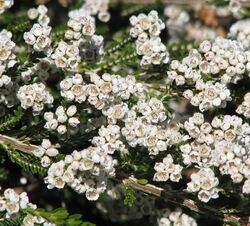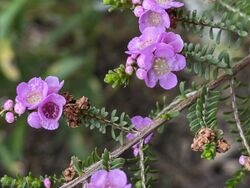Biology:Thryptomene
| Thryptomene | |
|---|---|

| |
| Thryptomene saxicola (white flower form) | |
| Scientific classification | |
| Kingdom: | Plantae |
| Clade: | Tracheophytes |
| Clade: | Angiosperms |
| Clade: | Eudicots |
| Clade: | Rosids |
| Order: | Myrtales |
| Family: | Myrtaceae |
| Subfamily: | Myrtoideae |
| Tribe: | Chamelaucieae |
| Genus: | Thryptomene Endl.[1] |
| Synonyms[1] | |
| |

Thryptomene is a genus of flowering plants in the family Myrtaceae and is endemic to Australia. Plants in the genus Thryptomene are shrubs with small leaves arranged in opposite pairs and white or pink flowers. About forty-seven species of Thryptomene, occurring in all Australian states and the Northern Territory, have been formally described.
Description
Plants in the genus Thryptomene are erect, slender shrubs typically growing to a height of 0.5–2.5 m (1 ft 8 in–8 ft 2 in) with small leaves arranged in opposite pairs with oil glands especially visible on the lower surface. The flowers are usually arranged singly or in pairs in leaf axils, and usually have five sepals, five white or pink petals and five, rarely ten or fifteen stamens. The fruit is a nut usually containing a single seed.[2][3][4]
Taxonomy
The genus Thryptomene was first formally described in 1838 by Stephan Ladislaus Endlicher in Stirpium Australasicarum Herbarii Hugeliani Decades Tres, published in the journal Annalen des Wiener Museums der Naturgeschichte and the first species described was Thryptomene australis.[5][6] The name Thryptomene means "made small".[7]
Species list
The following is a list of Thrypomene species accepted by the Australian Plant Census as of April 2021:[8]
Use in horticulture
Thryptomene saxicola has been cultivated for many years as a hardy garden plant and along with T. calycina is popular in the cut-flower trade.[9]
References
- ↑ 1.0 1.1 "Thryptomene". Australian Plant Census. https://biodiversity.org.au/nsl/services/apc-format/display/77151.
- ↑ "Thryptomene". State Herbarium of South Australia. http://www.flora.sa.gov.au/cgi-bin/speciesfacts_display.cgi?form=speciesfacts&name=Thryptomene.
- ↑ Wilson, Paul G.. "Genus Thryptomene". Royal Botanic Gardens Sydney. https://plantnet.rbgsyd.nsw.gov.au/cgi-bin/NSWfl.pl?page=nswfl&showsyn=&dist=&constat=&lvl=gn&name=Thryptomene.
- ↑ Jeanes, Jeff A.. "Thryptomene". Royal Botanic Gardens Victoria. https://vicflora.rbg.vic.gov.au/flora/taxon/88204fdf-9c6c-41df-b928-f593066566d1.
- ↑ "Thryptomene". APNI. http://id.biodiversity.org.au/instance/apni/491043.
- ↑ Endlicher, Stephan (1838). "Stirpium Australasicarum Herbarii Hugeliani Decades Tres". Annalen des Wiener Museums der Naturgeschichte 2: 192. https://www.biodiversitylibrary.org/page/41200333#page/206/mode/1up. Retrieved 23 April 2021.
- ↑ Sharr, Francis Aubi; George, Alex (2019). Western Australian Plant Names and Their Meanings (3rd ed.). Kardinya, WA: Four Gables Press. p. 118. ISBN 9780958034180.
- ↑ "Thryptomene". Australian Plant Census. https://biodiversity.org.au/nsl/services/search/taxonomy?product=APC&tree.id=51209179&name=Thryptomene&inc._scientific=&inc.scientific=on&inc._cultivar=&max=1000&display=apc&search=true.
- ↑ "Thryptomene saxicola". Australian Native Plants Society (Australia_. http://www.anpsa.org.au/t-sax.html.
Wikidata ☰ Q3275821 entry
 |

